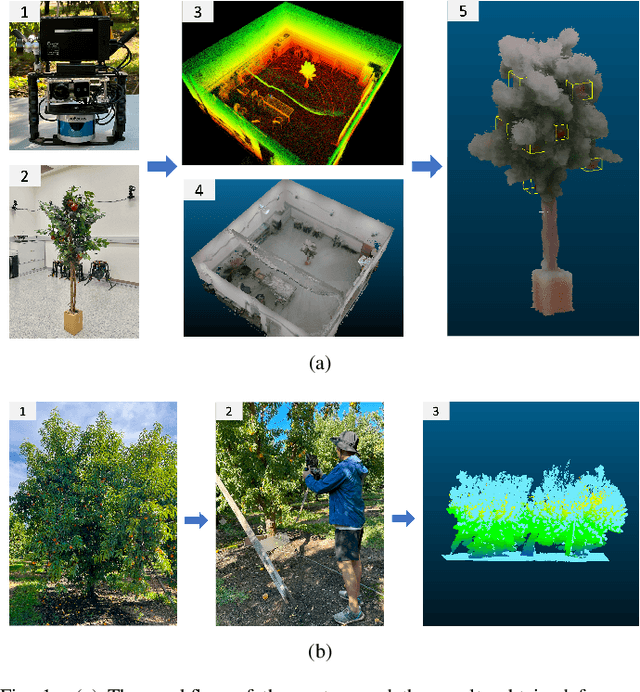Kaiming Fu
Fusion-Driven Tree Reconstruction and Fruit Localization: Advancing Precision in Agriculture
Oct 23, 2023
Abstract:Fruit distribution is pivotal in shaping the future of both agriculture and agricultural robotics, paving the way for a streamlined supply chain. This study introduces an innovative methodology that harnesses the synergy of RGB imagery, LiDAR, and IMU data, to achieve intricate tree reconstructions and the pinpoint localization of fruits. Such integration not only offers insights into the fruit distribution, which enhances the precision of guidance for agricultural robotics and automation systems, but also sets the stage for simulating synthetic fruit patterns across varied tree architectures. To validate this approach, experiments have been carried out in both a controlled environment and an actual peach orchard. The results underscore the robustness and efficacy of this fusion-driven methodology, highlighting its potential as a transformative tool for future agricultural robotics and precision farming.
Test Set Optimization by Machine Learning Algorithms
Oct 28, 2020



Abstract:Diagnosis results are highly dependent on the volume of test set. To derive the most efficient test set, we propose several machine learning based methods to predict the minimum amount of test data that produces relatively accurate diagnosis. By collecting outputs from failing circuits, the feature matrix and label vector are generated, which involves the inference information of the test termination point. Thus we develop a prediction model to fit the data and determine when to terminate testing. The considered methods include LASSO and Support Vector Machine(SVM) where the relationship between goals(label) and predictors(feature matrix) are considered to be linear in LASSO and nonlinear in SVM. Numerical results show that SVM reaches a diagnosis accuracy of 90.4% while deducting the volume of test set by 35.24%.
YouTube AV 50K: An Annotated Corpus for Comments in Autonomous Vehicles
Oct 15, 2018



Abstract:With one billion monthly viewers, and millions of users discussing and sharing opinions, comments below YouTube videos are rich sources of data for opinion mining and sentiment analysis. We introduce the YouTube AV 50K dataset, a freely-available collections of more than 50,000 YouTube comments and metadata below autonomous vehicle (AV)-related videos. We describe its creation process, its content and data format, and discuss its possible usages. Especially, we do a case study of the first self-driving car fatality to evaluate the dataset, and show how we can use this dataset to better understand public attitudes toward self-driving cars and public reactions to the accident. Future developments of the dataset are also discussed.
 Add to Chrome
Add to Chrome Add to Firefox
Add to Firefox Add to Edge
Add to Edge